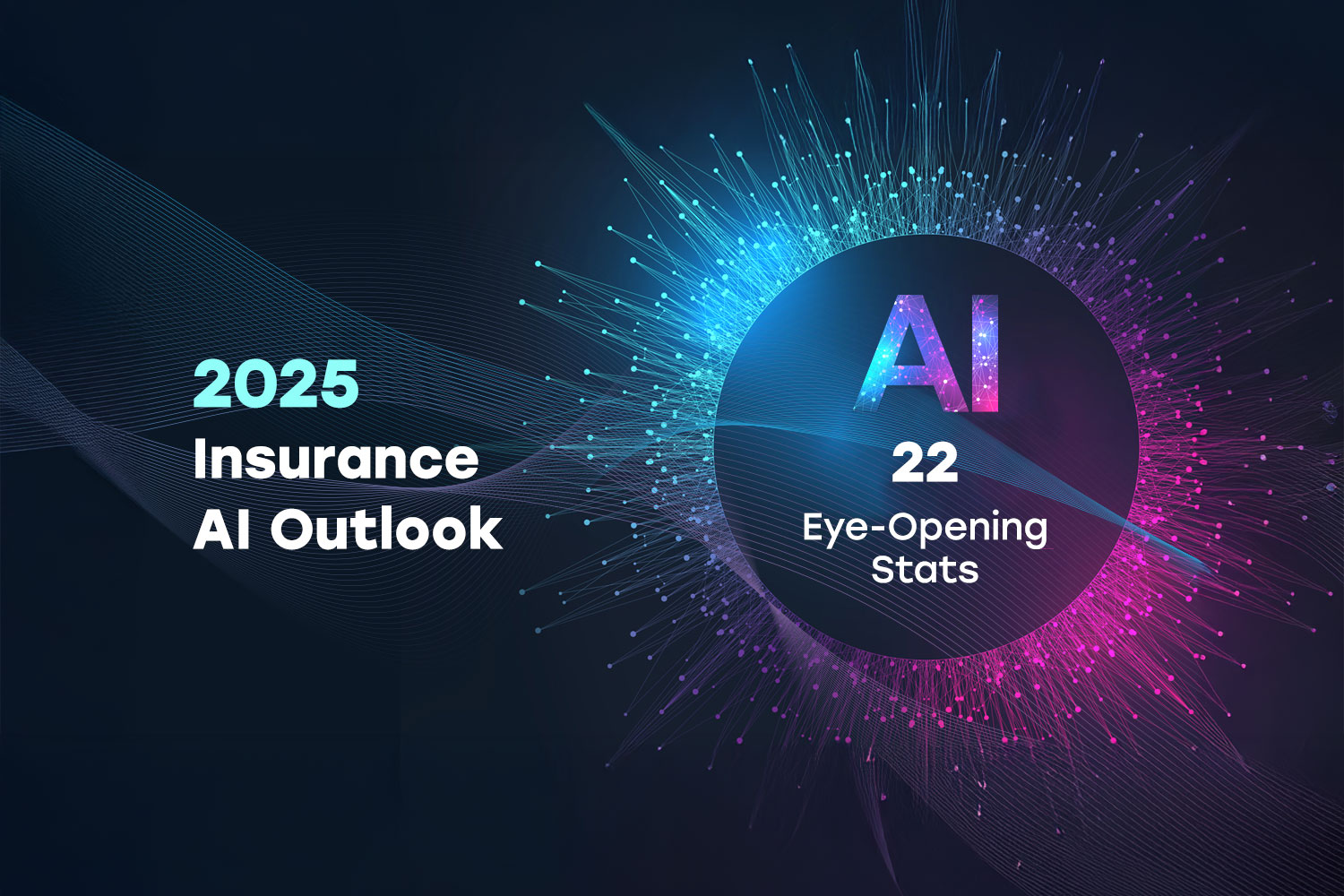2025 Insurance AI Outlook – 22 Eye-Opening Stats
Recent years have seen rapid development in insurance AI. What will 2025 bring? Below we’ve gathered some eye-opening statistics about AI adoption in insurance and beyond.
Business Leaders See Risk and Opportunity
Data shows that many leaders perceive AI as a double-edged sword, representing both risk and opportunity. Insurance leaders are currently split on whether it’s mostly positive or negative. One concern is the potential for increased cyber threats.
- The global AI in insurance market is projected to grow at a CAGR of 43.0% from 2024 to 2029. (Source: Market Research Future, June 2024)
- 68% of insurance CEOs view generative AI as a big threat. (Source: KPMG 2024 Insurance CEO Outlook)
- 51% of insurance CEOs see generative AI as an opportunity, whereas 49% see it as more of a risk. (Source: IBM)
- 80% of executives say their senior leadership’s risk aversion is causing them to embrace technology more slowly than their competitors. (Source: KPMG’s Global Tech Report)
- 54% of insurance CEOs say their organization is well prepared for a cyberattack, down from 66% in 2023. (Source: KPMG 2024 Insurance CEO Outlook)
Consumer Sentiment is Split
Consumer perception of AI is also split, although this may change as more people become used to using the technology in their daily lives.
- 43% of consumers are excited about generative AI, but 29% are concerned and 28% feel conflicted. (Source: BCG CCI Global Consumer Sentiment Survey)
- In the U.S., 75% of consumers have heard of ChatGPT and 23% have used it. (Source: BCG CCI Global Consumer Sentiment Survey)
Tech Adoption is Crucial to Survival
Despite concerns and divided consumer sentiment, insurance leaders know that the world is changing and that they need to adapt if they want to survive.
- 39% of CEOs believe their organization will not be economically viable in 10 years if it continues on its current course. (Source: PwC’s 26th Annual CEO Survey)
- 77% of insurance executives say they need to adopt generative AI quickly to keep up with competitors. (Source: IBM)
- 78% of executives say they worry about struggling to keep up with the pace of change. (Source: KPMG’s Global Tech Report)
AI May Reduce Costs
Faced with rising losses, insurers need to cut costs. As insurers look for ways to apply new technologies, process automation stands out as the top way to boost operational efficiency and reduce operating costs.
- 85% of CEOs say they have reduced operating costs or are considering doing so in the next 12 months, but only 19% say they have reduced compensation or plan to do so. (Source: PwC’s 26th Annual CEO Survey)
- 76% of CEOs say they are investing in automating processes and systems. (Source: PwC’s 26th Annual CEO Survey)
- AI-based pricing software is forecasted to save insurance companies up to 15% in operational costs by 2026. (McKinsey & Company, August 2024)
It May Also Fill Talent Gaps
Skilled worker shortages are another issue AI can address. As experienced workers retire, insurers are facing a growing talent gap. AI can help fill the gap by boosting productivity. Despite fears from many workers, net job loss is not expected.
- 62% of insurance CEOs are worried about the effect of talent gaps. (Source: KPMG 2024 Insurance CEO Outlook)
- 74% of executives say their organization is already seeing increased productivity among knowledge workers thanks to AI. (Source: KPMG’s Global Tech Report)
- 34% of workers fear that AI will lead to job displacement in the next five years. (Source: FlexJobs 2024 Future of Work Report)
- 0% of insurance CEOs think generative AI will eliminate more jobs than it creates. (Source: KPMG 2024 Insurance CEO Outlook)
Customer Experience is Key
Insurers are also struggling to keep up with changing consumer expectations, including demand for faster, more personalized processes. AI can help with this.
- 78% of executives say their business fails to use customer feedback effectively. (Source: KPMG’s Global Tech Report)
- 56% of CEOs say changing customer demand and preferences will have a large impact on profitability over the next 10 years. (Source: PwC’s 26th Annual CEO Survey)
AI Adoption Shows No Signs of Slowing
Ultimately, AI adoption is happening at a rapid pace and shows no signs of slowing.
- 77% of insurance executives say they are adopting AI in their value chain, up from 61% in 2023. (Source: Transformative AI Technology: Insights from Conning’s Executive Survey)
- The value of the global generative AI in insurance industry is expected to rise at a CAGR of 34.44% between 2023 and 2032, increasing from $761.4 million to $14.4 billion. (Source: Allied Market Research)
- The adoption of machine learning in insurance is expected to increase by 79% by 2025. (Source: Grand View Research, April 2024)
Insurance AI Outlook
As hype gives way to a more realistic view of technology, AI investments may evolve. Currently, many insurers are focusing on long-term plans.
Are your AI initiatives keeping up with the insurance AI 2025 outlook? Soteris can help auto insurers apply new AI technology in ways that matter – reducing costs, growing profitable business, and providing better customer experiences.





